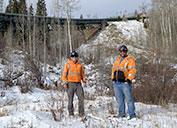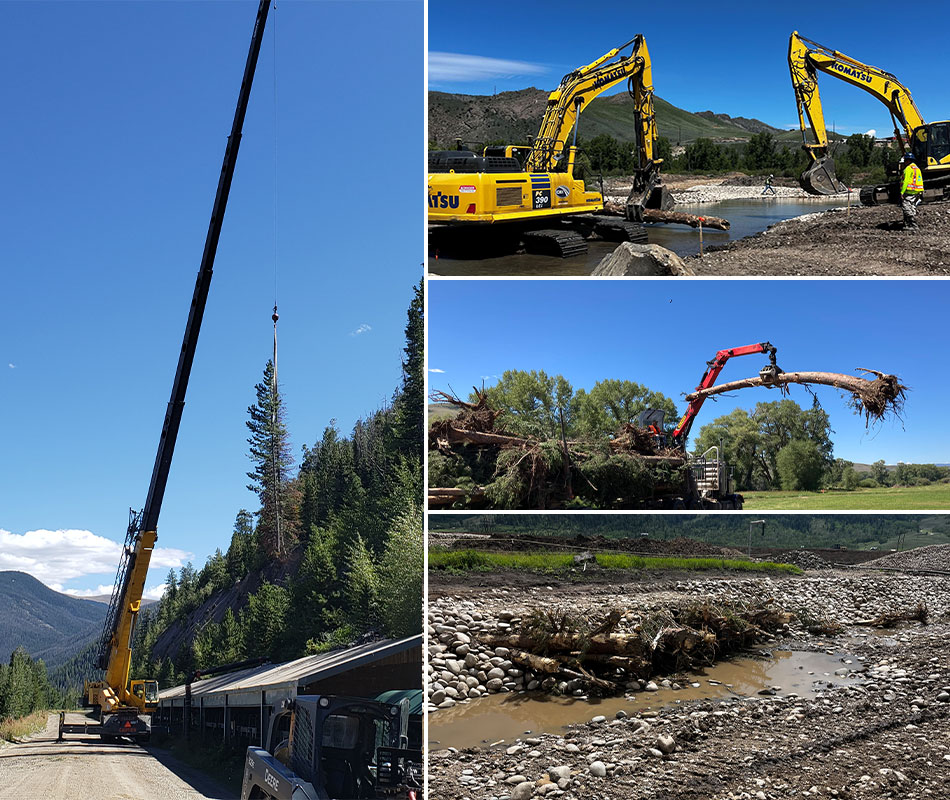Henderson Trees Prove Vital to Colorado River Restoration Project

 January 5, 2024 - Hundreds of trees removed from around the Henderson mill in Colorado for fire protection are being repurposed to help a pair of projects that will enhance the aquatic habitats and restore the unencumbered flow of the Colorado River near the company’s operations.
January 5, 2024 - Hundreds of trees removed from around the Henderson mill in Colorado for fire protection are being repurposed to help a pair of projects that will enhance the aquatic habitats and restore the unencumbered flow of the Colorado River near the company’s operations.
More than 500 trees have been removed from the site – located about 50 miles west of Denver -- over the past two years to thin the combustible fuels and protect the operation from devastating wildfires like the one that threatened the mill in 2020, said Kasey Martin, Senior Environmental Engineer. The trees were not of sufficient size and quality to sell them to a timber company in an already glutted market. So, initially it appeared the felled trees would have to be stored and left to decompose somewhere.
About the time the fire mitigation work was being planned, Geoff Niggeler, Chief Environmental Engineer, was having a conversation with Jon Ewert, an aquatic biologist at Colorado Parks and Wildlife. It turns out Ewert had long been working on a project to restore the flow of the Colorado River past the Windy Gap Reservoir and needed live trees to stabilize the banks and create fish habitat.
The solution to both problems was a natural.
Rather than cutting down with chain saws the trees around the mill, they were pushed over with bulldozers to keep their root balls intact. The trees then were loaded onto trucks and driven from the Henderson site to the Colorado River Connectivity Channel at the Windy Gap Reservoir about 30 miles away to be submerged in the channel. About 180 trees were shipped to Windy Gap. Another 400 or so trees went to the nearby Kemp-Breeze State Wildlife Area to improve the aquatic habitat of the Colorado River.
Intact roots fortified project
Keeping the root balls allowed the trees to be installed securely in the channel banks for stabilization.
“The biggest hiccup was finding large trees that would stabilize the banks and provide aquatic habitat as they reconstructed the river channels,” Niggeler said. “Hauling timber with the root wads and the branches connected can be dangerous. So, Colorado Parks and Wildlife struggled to find a source that’s close enough that somebody would be willing to haul that type of timber to the Colorado River projects sites. Our operation is right upstream from the projects, and so we were able to find a trucking company that was willing to do it with the quantity and type of wood they were looking for right here at the mill.”
The Windy Gap Reservoir was created for water storage in 1985 by damming the Colorado River. That cut off the uninterrupted flow of water in the river, resulting in habitat loss, sediment buildup and declining fish and insect populations. The Windy Gap project involves the construction of a new channel to connect the Colorado River and allow it to flow around the dam without sacrificing water storage.
The pine trees salvaged by the company and provided to the habitat restoration projects came from about 20 acres strategically selected to protect the mill facilities, Martin said. Bid specifications were written to require the trees to be knocked over rather than cut off, which protected the roots and made them viable for repurposing in river restoration. Contractors were hired to bring down the trees and transport them to the river projects.
It was tricky work. At times there were cranes moving trees over the mill’s conveyors. Yet the job was completed without any injuries.
Niggeler said the success of the company’s collaboration with Colorado Parks and Wildlife illustrates Henderson’s commitment to be good neighbors and a positive force in the region. It came about because of the close relationships maintained with state and local governments, wildlife and environmental agencies, and local nongovernmental organizations.
“These projects were not just meant to sustain aquatic life but also to sustain the tourism industry around the Colorado River,” Niggeler said. “We are not just a corporate checkbook. We are a partner and that’s where we have the social license to operate.”

Photos (top right; bottom clockwise): Geoff Niggeler and Kasey Martin stand in an area cleared of vegetation for fire protection; Large cranes were used to hoist trees over equipment used at the Henderson mill; Removing trees in a way they could be repurposed for river restoration projects proved complex, but was accomplished without any injuries; Delivering trees with their roots intact was necessary for the habitat restoration work in the Windy Gap Reservoir area; Trees were installed in a manner that stabilized the channel.



 BACK
BACK
SOCIAL
RECOGNITION